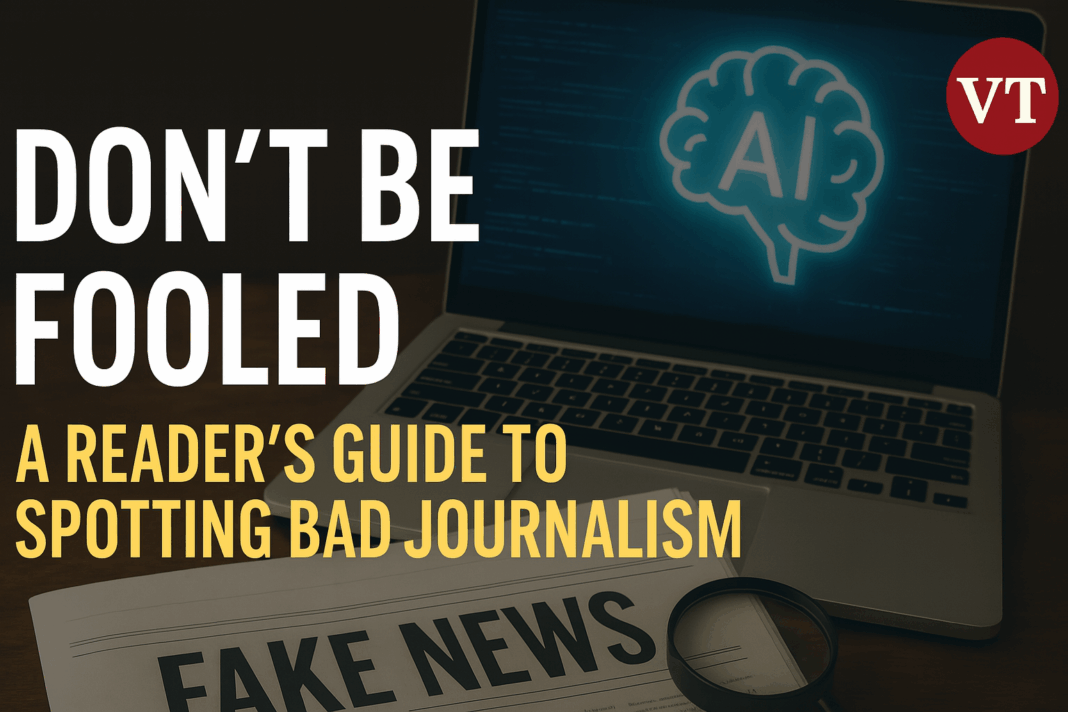- Good journalism cites verifiable sources, offers balanced views, and maintains editorial transparency.
- AI is now used in over 85% of global newsrooms, offering efficiency but also ethical challenges.
- Readers should evaluate news based on sources, transparency, balance, and editorial standards.
- Bad journalism thrives on sensationalism, vague claims, and unchecked use of AI tools.
- Credibility today requires both digital literacy and a strong understanding of journalistic values.
The Big Picture
In an era dominated by social media scrolls and algorithm-driven content, the difference between good and bad journalism is both urgent and increasingly difficult to discern. As artificial intelligence (AI) revolutionizes the newsroom, distinguishing truth from noise requires sharper media literacy and a deeper understanding of how news is made—and who is making it.
What’s Good Journalism?
Good journalism is rooted in truth-seeking and public service. It provides clear attribution, fair context, and discloses any potential bias. It respects readers’ intelligence by offering facts before opinions, and evidence before emotion. For example, news from outlets like Reuters or AP is often fact-checked, attributed, and globally contextualized.
What’s Bad Journalism?
By contrast, bad journalism chases clicks with sensational headlines, omits sources, and often relies on AI-generated content without oversight. These stories lack transparency and often use emotionally charged language to provoke reaction rather than reflection. An example would be viral articles with dramatic claims like “TRUMP SHOCKER ON EPSTEIN CASE” that lack dates, quotes, or named sources.
The Role of AI in Journalism
AI has become a powerful tool in modern newsrooms, but its use must be transparent and ethically guided. According to a 2024 report by Julien Florkin, over 85% of newsrooms worldwide use some form of AI. Additionally, a report found that 57% of surveyed media organizations plan to increase their AI investment—underscoring its growing role in editorial decision-making.
Key Applications of AI in Newsrooms
- Automated News Writing: AI tools like Wordsmith (AP), Heliograf (Washington Post), and Cyborg (Bloomberg) generate fast, structured reports for earnings, elections, and sports.
- Data Journalism: AI helps analyze massive datasets for trends, fraud, or hidden patterns. Pulitzer-winner Sarah Cohen says: “Data journalism is about telling stories with numbers. AI helps us find those stories faster and more accurately.”
- Content Personalization: Around 60% of outlets use machine learning to serve readers articles based on behavior and interests.
- Fact-Checking: AI bots cross-reference claims in real time, flagging misleading or false information. Clara Jeffery, Editor-in-Chief at Mother Jones, states: “AI-powered fact-checking tools are becoming indispensable in the fight against misinformation.”
- Multimedia Journalism: From editing video to labeling images, AI is accelerating how quickly visual news is produced and published.
Examples of AI-Generated News
Source: Julien Florkin – AI for Journalists
| News Organization | AI Tool Used | Type of Content Generated |
|---|---|---|
| Associated Press | Wordsmith | Earnings Reports |
| Washington Post | Heliograf | Sports & Election Updates |
| Bloomberg | Cyborg | Market & Finance Reports |
What the Industry Is Saying About AI in Journalism
Artificial Intelligence is actively reshaping journalism, from editorial workflows to public trust. Below are three of the most widely respected articles from major publications that critically examine how AI is being integrated into modern newsrooms:
-
The Newspaper That Hired ChatGPT — The Atlantic
A behind-the-scenes look at Italy’s Il Foglio, which launched a month-long daily AI editorial insert generated using ChatGPT and reviewed by human editors. -
Will A.I. Save the News? — The New Yorker
This essay explores whether AI will be a savior or threat to journalism, emphasizing the need for human oversight and fact-based integrity. -
Rise of Super Journalists — Axios
Axios co-founder Jim VandeHei outlines a future where journalists use AI to report faster and with more depth, not less credibility.
Expert Quotes on AI in Journalism
- “Artificial intelligence will transform the news business. But it won’t replace journalists.” – Nick Diakopoulos, Northwestern University
- “AI tools are an extension of the journalist’s toolkit… but the core skills of journalism remain essential.” – John Keefe, WNYC
- “AI-powered fact-checking tools are becoming indispensable in the fight against misinformation.” – Clara Jeffery, Mother Jones
What They’re Saying
“Good journalism uses AI to support research. Bad journalism uses AI to skip it entirely.”
Closing Thought
“Journalism is not about what tools you use—it’s about how committed you are to truth, accuracy, and public accountability.”
The Bottom Line
AI is not the enemy of journalism—but bad faith use of it might be. The tools are powerful, but like any powerful tool, they require accountability. In a media environment driven by speed and algorithms, truth takes time. And good journalism takes effort—on both sides of the screen.
AI Is Not the Enemy—Dishonesty Is
AI For Journalists – 10 Best Practices to Boost Newsroom Efficiency
About the Author: Sunil Dahal is a freelance writer based in the Washington D.C. metro area. He writes on social, political, environmental, ethical, and public interest topics across national and international landscapes.
Follow Virginia Times for regular news updates. Stay informed with the latest headlines, breaking stories, and in-depth reporting from around the world.
Freelance Writer














